Menus
- Haute couture headwear
- 10,000 km test
- Discovery
- Threading
- Dynamic test
- Carbon fragility
- Visor disassembly / assembly
- Conclusion
- Technical sheet
Haute couture headwear
10,000 km test
The Shark RSI Carbon helmet with a composition of carbon fiber (35%), multi-axial fiber (15%), aramid fiber (15%) and exposy resin (35%) is in the high end of the manufacturer, just after Race Pro, Race R and RSI Pro competition helmets. Use is intended sport / road.
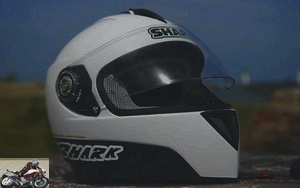
Its dynamic aesthetic and its mixed construction of multiaxial fibers and visible carbon give it a real elegance. And on the security side, it claims 4 stars in the Sharp test.
Discovery
Terribly seductive on the outside, the RSI Carbon is adorned with tight angles and curves. Accessorization follows the same lines: air intake elements, extractors and rear aerodynamic spoiler … The origins of the tracks are noticeable. Of course, these are the areas where the carbon fiber appears that flatter the eye.
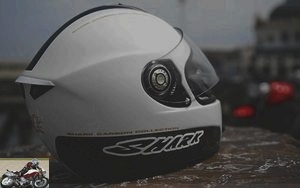
This construction offers above all an argument of lightness: 1250 g announced according to the size (1290 g verified on the scale in size M). In fact, this Shark is very light in hand and pleasant to handle. It seems even less heavy in white, due to less visual presence.
The helmet offers an excellent finish: quality of materials, matte surface of plastics, ventilation grilles: the components are neat. The fit of the different elements and foams cannot be criticized. Special mention for the nose deflector, provided at its base with gunmetal-colored metal claws. A surprising refinement.
Also notable is the visor retention system, perfectly integrated, contributing to the competition image. The screen can be fitted with a pinlock system, absent from the test model.
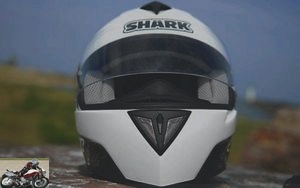
Threading
The RSI Carbon is easy to set up. The surface fabric is very soft. Rather firm foams effectively support the face but give a tight feeling. This sensation is the same for the field of vision. However the general comfort is very good. No pressure point or lack of insulating material is noticeable. In addition, the interior is completely removable and washable. Safety is ensured by internal cushioning with multiple elements of differentiated densities.
Eyeglass wearers, depending on their morphology and glasses, will have more or less ease in placing their binoculars. But overall, things are going well.
The chinstrap is tightened with a double D buckle, in accordance with sport-oriented use. However, this one is sheathed in velvet, top of the range obliges! A significant amenity, more qualitative than simple protective legs.
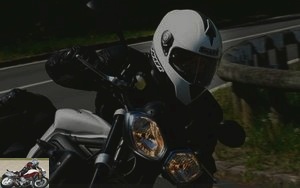
Dynamic test
From the first few hundred meters, we appreciate the screen that can be adjusted smoothly in 6 positions. The first notch, very narrow opening for a trickle of air, makes it possible to manage the fog during urban evolutions in winter. This is indeed the immediate weak point of this helmet: the visor charges up fairly quickly with water vapor. The vents are only effective at higher speeds, i.e. above 80 km / h.
Their opening and closing controls are intuitive … unlike the screen, whose lug is off-center at the edge of the field of vision on the left side. Not always very pleasant to handle.
The RSI Carbon has average soundproofing. Correct on courses of less than 100 km, and peri-urban journeys, the noise will be less bearable on longer stages. This is due to the excessively light anti-swirl bib, combined with the pointed shape of the helmet. Thus, a large space under the chin generates air flow, hissing and cold in winter.
On the track, its a little tight ventilation will quickly make it hot in summer. However, we benefit from good aerodynamics. The minimalist rear spoiler helps stabilize the head. Without forgetting the really reduced weight which brings real comfort on a daily basis. This is the "magic" of carbon fibers.
Carbon fragility
Be careful, however, when handling! The carbon turns out to be fragile on the outside. One day when the helmet slipped between my hands, I wanted to catch it in "flight" with the palm of my hand. The helmet fell from less than a meter, without touching the ground, but only my hand. And that was enough to create a “round solid”. The fiber played in shock. And the result is clearly visible on the outside.

Visor disassembly / assembly
The “Push One” disassembly / reassembly system is one of the best available on the market. In the maximum open position, all you have to do is press firmly on the fixing plates and the visor is released. Same principle to replace it. Efficient, simple and safe.
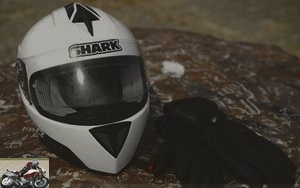
Conclusion
Pleasant on a daily basis in urban development or during track sessions, this helmet is not necessarily the best for cutting the road. But the RSI Carbon relies as much on its dynamic performance as its plastic with exemplary finishes. Able to seduce bikers demanding their look.
While all-carbon products can be found on the market, their prices are far from commensurate. The price of € 399 gives the Shark an excellent place in a relatively uncompetitive niche: haute couture sport.
Colors: black, white, red, orange
Strong points
- Finishing
- Price
- Style
Weak points
- Perfectible ventilation
- Fog on the screen (excluding pinlock)
- Offset visor tab
Available in sizes XS (53 ~ 54cm), S (55 ~ 56cm), M (57 ~ 58cm), L
(59 ~ 60cm), XL (60 ~ 61cm).
Technical sheet
- Exclusive structure
SHARK in multiaxial fibers and carbon. - Two volumes of caps
- Multi-element internal armotor
(5) at differentiated densities - Circulation of air flows through integrated channels and
"Venturi" deflectors - 2.2mm screen with Pinlock
- "Push One" quick-release screen
- Interior fully removable, adjustable and
washable - Ergonomic cheek pads
- Anti-fog mask and anti-swirl bib
- Chin strap buckle
Racing DD - Average weight in size M:
1290g
Tips for choosing the right helmet |
All opinions on Shark helmets
The manufacturer’s website
Related articles
-
Roof RO200 Carbon full-face helmet test
The full race of 1.090 grams ! Carbon shell, multi-density liner, Silent Lining interior, multiple vents… 1,090 grams, 210 ° field of vision…
-
AGV AX9 Carbon full face helmet test
I am your helmet 5,000 km test Before, there were road helmets, sports helmets and cross country helmets. There are now enduro touring helmets, to…
-
Modular motorcycle helmet test: Shark Evoline
The first helmet approved for both Integral and Jet 6,000 kilometers with the Shark Evoline The Shark EvoLine helmet is not a traditional modular. At…
-
Shark Spartan Carbon full face helmet test
14 colors, 1290 grams, ventilations, internal sunscreen, from 320 € A racy full face, but comfortable and very stylish with its visible carbon Between…
-
Shark Speed-R 2 full face helmet
5,000 km test Elegant and super-equipped Successor of the Speed-R, the Speed-R series 2 is the evolution of the fiber model. Its surname announces it…
-
Roof Boxxer Carbon modular helmet test
6 colors, 7 sizes from XS to XXL, double jet and full homologation, 529 € The French brand is finally changing its modular star Concerning them, there is…
-
Shoei Neotec II modular helmet test
7 years ! It has been seven years since Shoei presented its Neotec, to finally compete with the Schuberth C3. After 30,000 km of Neotec testing, the…
-
Full face helmet Nishua NXR-1 Carbon
Competition look 5,000 km test Nishua is a brand of the Louis.de equipment manufacturer, offering a range of helmets with a very attractive…
-
Nishua NFX-2 Carbon modular helmet test
Carbon at a low price After its NXR-1 and enduro carbon helmets, Louis offers the modular Nishua NFX-2 Carbon, itself an evolution of the standard NFX-2,…
-
Nexx XR1R motorcycle helmet test
2000 km test Nexx is a Portuguese company that manufactures full face helmets (XR1 and X10), cross (X20), maxi-jet (X30) and jet Open Face (X60). The…